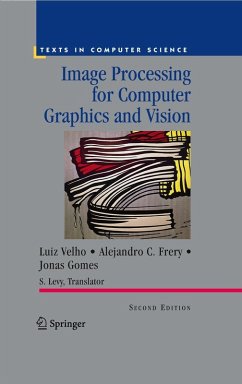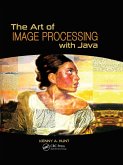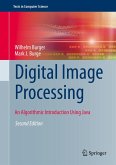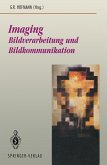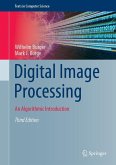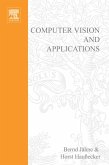Image processing is concerned with the analysis and manipulation of images by computer. Providing a thorough treatment of image processing, with an emphasis on those aspects most used in computer graphics and vision, this fully revised second edition concentrates on describing and analyzing the underlying concepts of this subject.
As befits a modern introduction to this topic, a good balance is struck between discussing the underlying mathematics and the main topics of signal processing, data discretization, the theory of color and different color systems, operations in images, dithering and half-toning, warping and morphing, and image processing. Significantly expanded and revised, this easy-to-follow text/reference reflects recent trends in science and technology that exploit image processing in computer graphics and vision applications. Stochastic image models and statistical methods for image processing are covered, as is probability theory for image processing, and a focus on applications in image analysis and computer vision.
Features:
. Includes 5 new chapters and major changes throughout
. Adopts a conceptual approach with emphasis on the mathematical concepts and their applications
.Introduces an abstraction paradigm that relates mathematical models with image processing techniques and implementation methods - used throughout to help understanding of the mathematical theory and its practical use
. Motivates through an elementary presentation, opting for an intuitive description where needed
. Contains adopted innovative formulations whenever necessary for clarity of exposition
. Provides numerous examples and illustrations, as an aid to understanding
. Focuses on the aspects of image processing that have importance in computer graphics and vision applications
. Offers a comprehensive introductory chapter for instructors
Thiscomprehensive text imparts a good conceptual understanding of the topic, as a basis for further study, and is suitable both as a textbook and a professional reference. The current extended edition is a must-have resource and guide for all studying or interested in this field.
As befits a modern introduction to this topic, a good balance is struck between discussing the underlying mathematics and the main topics of signal processing, data discretization, the theory of color and different color systems, operations in images, dithering and half-toning, warping and morphing, and image processing. Significantly expanded and revised, this easy-to-follow text/reference reflects recent trends in science and technology that exploit image processing in computer graphics and vision applications. Stochastic image models and statistical methods for image processing are covered, as is probability theory for image processing, and a focus on applications in image analysis and computer vision.
Features:
. Includes 5 new chapters and major changes throughout
. Adopts a conceptual approach with emphasis on the mathematical concepts and their applications
.Introduces an abstraction paradigm that relates mathematical models with image processing techniques and implementation methods - used throughout to help understanding of the mathematical theory and its practical use
. Motivates through an elementary presentation, opting for an intuitive description where needed
. Contains adopted innovative formulations whenever necessary for clarity of exposition
. Provides numerous examples and illustrations, as an aid to understanding
. Focuses on the aspects of image processing that have importance in computer graphics and vision applications
. Offers a comprehensive introductory chapter for instructors
Thiscomprehensive text imparts a good conceptual understanding of the topic, as a basis for further study, and is suitable both as a textbook and a professional reference. The current extended edition is a must-have resource and guide for all studying or interested in this field.
Dieser Download kann aus rechtlichen Gründen nur mit Rechnungsadresse in A, B, BG, CY, CZ, D, DK, EW, E, FIN, F, GR, HR, H, IRL, I, LT, L, LR, M, NL, PL, P, R, S, SLO, SK ausgeliefert werden.
From the reviews of the second edition:
"The mathematical aspects of image processing are emphasized in this book ... . I found useful information in all of the chapters, for reasons of personal bias, I found some chapters more interesting than others-- especially 'Color Quantization,' 'Digital Halftoning' (dithering), 'Combining Images,' and 'Warping and Morphing.' Chapters can be read independently, and each includes a bibliography. The presentation is well structured and clear." (O. Lecarme, ACM Computing Reviews, June, 2009)
"The book is devoted to image processing techniques with an emphasis on the aspects most used in computer graphics and vision. ... The book is presented in an accessible fashion, with many illustrations and examples. ... It is suitable both as a textbook and as a professional reference for students, researchers and engineers. It is a great starting point for those who want to use computer graphics and vision in research or are interested in the field." (Agnieszka Lisowska, Mathematical Reviews, Issue 2011 j)
"The mathematical aspects of image processing are emphasized in this book ... . I found useful information in all of the chapters, for reasons of personal bias, I found some chapters more interesting than others-- especially 'Color Quantization,' 'Digital Halftoning' (dithering), 'Combining Images,' and 'Warping and Morphing.' Chapters can be read independently, and each includes a bibliography. The presentation is well structured and clear." (O. Lecarme, ACM Computing Reviews, June, 2009)
"The book is devoted to image processing techniques with an emphasis on the aspects most used in computer graphics and vision. ... The book is presented in an accessible fashion, with many illustrations and examples. ... It is suitable both as a textbook and as a professional reference for students, researchers and engineers. It is a great starting point for those who want to use computer graphics and vision in research or are interested in the field." (Agnieszka Lisowska, Mathematical Reviews, Issue 2011 j)

